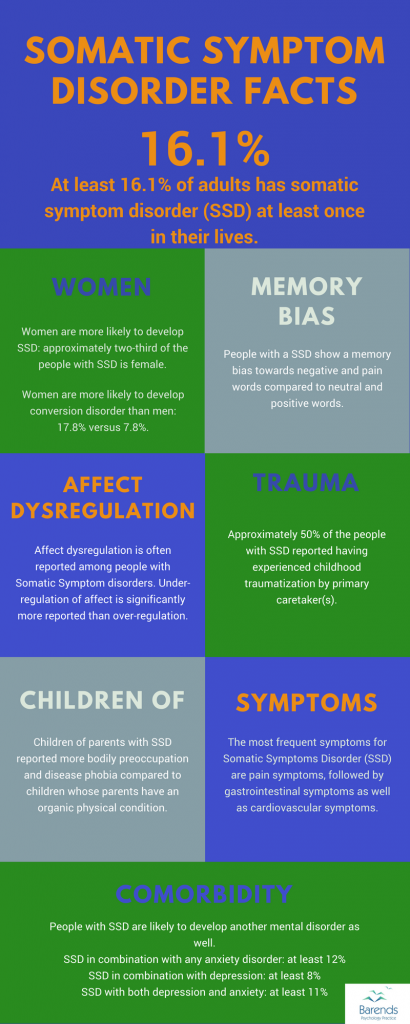What is somatic symptom disorder?

Someone with a somatic symptom disorder (SSD) experiences physical symptoms, such as pain or fatigue, which cannot be fully explained by (1) a general medical condition, (2) substance use, or (3) another mental disorder.The somatic symptoms are either very distressing or result in significant disruption of functioning. Also, the person must experience excessive and disproportionate thoughts, behaviours, and feelings regarding those somatic symptoms. These symptoms must be present for at least 6 months.
Somatic symptom disorders, formerly known as somatization disorder, is treatable with cognitive behavioural therapy (CBT) [1],[3] and in some cases with brief psychodynamic interpersonal psychotherapy (PIT) [2]. Approximately 5.6% of people reaches subthreshold SSD in their lives [4],[5], and more women than men develop this mental disorder [5],[6],[7].
One in two people with somatic symptom disorder report childhood traumatization by a primary caretaker [8], which suggests that PTSD treatment may be beneficial for these people, which is supported by research, although preliminary [9].
This page explains what somatic symptom disorder is and how you can recognize it. Also, on this website you can find information about its causes, treatment, facts, you can fill in an online SSD questionnaire and read how to cope with SSD yourself.
Jump to:
- What causes SSD?
- SSD diagnosis.
- How can SSD be treated?
- Take the SSD test.
- How to cope with SSD?
- Partner with SSD.
- Interesting SSD facts.
- Online counseling for SSD
- Take me to the homepage.
At Barends Psychology Practice, we offer (online) therapy for somatic symptom disorder. Contact us to schedule a first, free of charge, online session. (Depending on your health insurance, treatment may be reimbursed).
Recognizing somatic symptom disorder
Not everyone who experiences distressing somatic symptoms meets the criteria for somatic symptoms disorder (SSD). These somatic symptoms have to be accompanied by either a persistent high level of anxiety regarding the symptoms or health in general, or devote a lot of time and energy to these symptoms or their health, or must have excessive thoughts and worries about these symptoms.
Examples of somatic symptoms are:
- Headache
- Bloating
- Blushing or flushing
- Back pain
- Joint pain
- Abdominal pain
- Pain during intercourse
SSD usually develops between adolescence and early adulthood. SSD is most prevalent among 20 year olds [2]. Certain somatic symptoms are more common among people aged 45 and older: erectile dysfunction, loss of memory, deafness, joint pain, pain in extremities, palpitation, or urological problems [10].
When to seek professional help
It is important to reach out to a professional (psychiatrist, psychologist) if you recognize most of the above stated definition. If you have the feeling there is something not quite right, it’s better to contact a professional. In general, the longer people experience mental health issues, the higher the chance that these mental health issues worsen over time.
Literature
- [1] Sumathipala, A. (2007). What is the evidence for the efficacy of treatments for somatoform disorders? A critical review of previous intervention studies. Psychosomatic medicine, 69, 889-900.
- [2] Sattel, H., Lahmann, C., Gündel, H., Guthrie, E., Kruse, J., Noll-Hussong, M., … & Schneider, G. (2012). Brief psychodynamic interpersonal psychotherapy for patients with multisomatoform disorder: randomised controlled trial. The British Journal of Psychiatry, 200, 60-67.
- [3] Kroenke, K. (2007). Efficacy of treatment for somatoform disorders: a review of randomized controlled trials. Psychosomatic medicine, 69, 881-888.
- [4] De Waal, M. W., Arnold, I. A., Eekhof, J. A., & Van Hemert, A. M. (2004). Somatoform disorders in general practice. The British Journal of Psychiatry, 184, 470-476.
- [5] Jacobi, F., Wittchen, H. U., Hölting, C., Höfler, M., Pfister, H., Müller, N., & Lieb, R. (2004). Prevalence, co-morbidity and correlates of mental disorders in the general population: results from the German Health Interview and Examination Survey (GHS). Psychological medicine, 34, 597-611.
- [6] Becker, S., Al Zaid, K., & Al Faris, E. (2002). Screening for somatization and depression in Saudi Arabia: a validation study of the PHQ in primary care. The International Journal of Psychiatry in Medicine, 32, 271-283.
- [7] Roca, M., Gili, M., Garcia-Garcia, M., Salva, J., Vives, M., Campayo, J. G., & Comas, A. (2009). Prevalence and comorbidity of common mental disorders in primary care. Journal of affective disorders, 119, 52-58.
- [8] Annemiek van, D., Julian D, F., Onno van der, H., Maarten JM, V. S., Peter GM, V. D. H., & Martina, B. (2011). Childhood traumatization by primary caretaker and affect dysregulation in patients with borderline personality disorder and somatoform disorder. European Journal of Psychotraumatology, 2, 5628.
- [9] van Rood, Y. R., & de Roos, C. (2009). EMDR in the treatment of medically unexplained symptoms: A systematic review. Journal of EMDR Practice and Research, 3, 248-263.
- [10] Rief, W., Hessel, A., & Braehler, E. (2001). Somatization symptoms and hypochondriacal features in the general population. Psychosomatic medicine, 63, 595-602.
You must download the mobile application parimatch iphone only from the official site of the bookmaker’s office to exclude the possibility of downloading pirated content, which can cause material damage.
